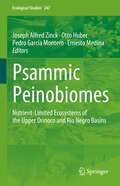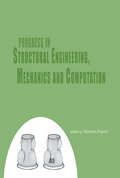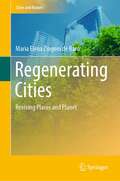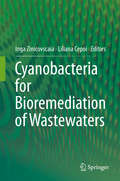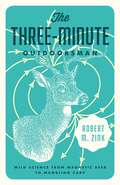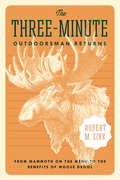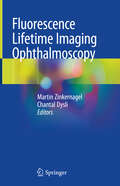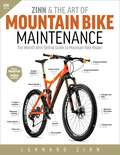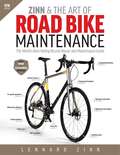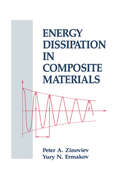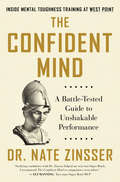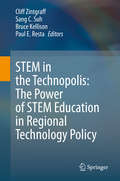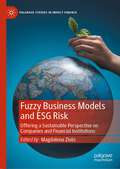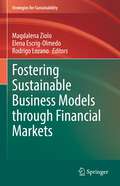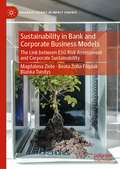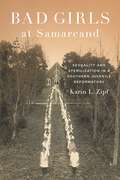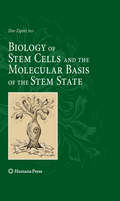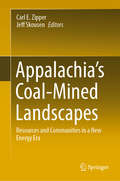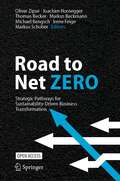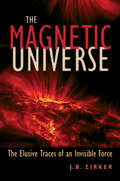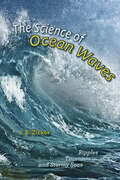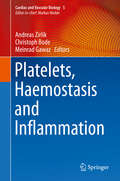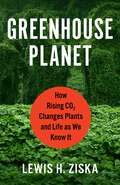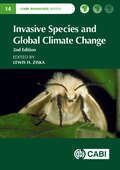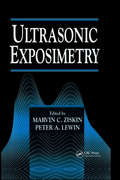- Table View
- List View
Psammic Peinobiomes: Nutrient-Limited Ecosystems of the Upper Orinoco and Rio Negro Basins (Ecological Studies #247)
by Joseph Alfred Zinck Otto Huber Pedro García Montero Ernesto MedinaThe book represents a multidisciplinary approach to understanding soil–landscape–vegetation relationships and, specifically, the ecophysiology of plant communities developing on sandy soils of very low fertility that are subject to seasonal flooding. It provides an overview of the white sand ecosystems within the Amazon basin, and focuses on the forest and herbaceous (meadows) vegetation growing on the dystrophic sandy soils of the upper Negro and Orinoco river basins. Several chapters describe physiographic aspects of the study area using integrated remote sensing and in situ sampling. By doing so they attain a comprehensive description of the origin and evolution of soils and landscapes, an advanced classification of soils, and a mapping of the geographic distribution of psammophilous vegetation. This volume also provides a phytosociological classification of extensive forested areas, and a detailed description of the structure and diversity of little-known herbaceous formations.It targets professionals in the fields of ecology, ecophysiology, geomorphology, soils, vegetation, and the environmental sciences. The information it offers may be of significant use to researchers, protected area planners, and environmental policy makers.
Progress in Structural Engineering, Mechanics and Computation: Proceedings of the Second International Conference on Structural Engineering, Mechanics and Computation, Cape Town, South Africa, 5-7 July 2004
by Alphose ZingoniThe Second International Conference on Structural Engineering Mechanics and Computation was held in Cape Town, South Africa in 2004. Its mission was 'To review and share the latest developments, and address the challenges that the present and the future pose'.This book contains its key findings with contributions from academics, researchers and pra
Regenerating Cities: Reviving Places and Planet (Cities and Nature)
by Maria Elena Zingoni de BaroThis book sets out the discussion on how cities can contribute solutions to some of the challenges the urbanised world is facing, such as the pressure of growing populations, mitigation of effects of, and adaptation to globally changing environmental, climate and public health conditions. Presenting a detailed explanation of the causes behind the current state of modern cities, the book advocates for a paradigm shift to improve the quality of life of ever-increasing urban inhabitants whilst nourishing the natural systems that sustain human and non-human life in the planet. Recognising the precious role that nature plays in the functioning of cities, it delves into the study of biophilic design and regenerative development. The book argues that these social-ecological design approaches can act as catalysts to develop conditions in urban settings that are beneficial for natural and human systems to thrive and flourish, both in ecosystem services and social-cultural systems. This is particularly relevant for the design of new quality precincts or the regeneration of degraded urban spaces to promote health, wellbeing and urban resilience. A framework is proposed to guide the process of thinking about, designing and building healthier, more liveable and resilient urban environments that raise the quality of life in cities. The method can be used by researchers, practitioners -urban designers, urban planners, architects and landscape architects- interested in developing their work within a social-ecological perspective. It can also be used by local governments and agencies to underpin policy making, and by educational institutions to prepare graduates with necessary skills to respond to current and future built environment challenges.
Cyanobacteria for Bioremediation of Wastewaters
by Inga Zinicovscaia Liliana CepoiThis book reflects the use of cyanobacteria for the bioremediation of wastewater through different mechanisms and pathways of transformation and transfer of hazardous substances from one medium to another. The application of microorganisms for bioremediation is determined by their ubiquity, small size, high rate of reproduction and large surface-to-volume cell ratio. Mechanisms of interaction of cyanobacteria with inorganic pollutants include biosorption, bioaccumulation with an opportunity to obtain metal nanoparticles both on the cell surface and inside the cells as well as chelation and inclusion of metals in the composition of certain organic structures. Data presented in the book provides specialists in the field with useful information for bioremediation technologies as well as for obtaining valuable preparations using cyanobacteria.
The Three-Minute Outdoorsman
by Robert M. ZinkThere are days when, if we hunt or fish or watch birds, we just want to be alone with our thoughts. Other times, however, contemplating the great outdoors that contains so many unknowns, we may wish to learn about moaning moose . . . or mumbling carp . . . or magnetic deer. And this is where Robert M. Zink enters the scene. A writer who humorously bridges the gap between esoteric information and nature as we have come to know it, Zink distills the latest news from the world of science into three-minute bursts of irresistible lore for the layman. In these brief, engaging essays readers will discover, for instance, how deer use the earth's magnetic field for orientation; a long-gone tradition of hunting loons in North Carolina; how porcupine quills are advancing new ideas about delivering inoculations; and why deer antlers can model bone regeneration for amputees. How do predator-prey cycles get started? Should we worry about black bear attacks in the woods? Zink has the answers--often to questions we didn't think to ask but wish we had. This is the outdoors at its mysterious best, as the experience of nature and the findings of science combine to educate our sense of wonder and tickle our fancy--to say nothing of our highly unscientific funny bone.
The Three-Minute Outdoorsman Returns: From Mammoth on the Menu to the Benefits of Moose Drool
by Robert M. ZinkSpending time in nature can raise some serious questions. After contemplating your own mortality, you may start to wonder: Why don’t deer noses freeze in the winter? What does mammoth taste like? Do fish feel pain? These are important questions, and Robert M. Zink has the answers. Bringing together the common and the enigmatic, The Three-Minute Outdoorsman Returns includes over seventy three-minute essays in which Zink responds to the queries that have yet to cross your mind. Drawing on his zoological background, Zink condenses the latest scientific discoveries and delivers useful, entertaining information on the great outdoors. Can a sheep’s horns be too big? Was the Labrador duck a hybrid? Why did I miss that clay target? A large section on deer covers topics ranging from deer birth control backfiring, new information on Chronic Wasting Disease, supplemental feeding, and deer genetics. Other essays explore land, aquatic animals, and humanity’s relationship with nature, thus making this book of wild science an essential for any outdoors person.
Fluorescence Lifetime Imaging Ophthalmoscopy
by Martin Zinkernagel Chantal DysliThis book focuses on the emerging non-invasive imaging technique of Fluorescence Lifetime Imaging Ophthalmoscopy (FLIO). FLIO reveals unique information on retinal diseases, ranging from age-related macular degeneration and vascular diseases to hereditary retinal dystrophies. Fluorescence lifetimes enable the evaluation of disease progression before irreversible structural changes occur. The image acquisition is suitable for diagnostic purposes and follow-up examinations to investigate the natural course of disease, and to monitor the effects of possible therapies. This book fills the gap between available literature and gives state-of-the-art guidance on the principles of the FLIO technique, image acquisition, and data analysis. Written by a team of expert leaders within this field, this book will be relevant for scientists and clinicians with an interest in ophthalmoscopy.
Zinn & the Art of Mountain Bike Maintenance: The World's Best-Selling Guide to Mountain Bike Repair
by Lennard ZinnZinn & the Art of Mountain Bike Maintenance is the world&’s best-selling guide to the maintenance and repair of mountain bikes, hybrids, and fat bikes.From basic repairs like how to fix a flat to advanced overhauls of drivetrains and brakes, Lennard Zinn&’s clearly illustrated guide makes every bike repair and maintenance job easy for everyone. Lennard Zinn is the world&’s leading expert on bike maintenance and repair. His friendly, step-by-step guide explains the tools and parts you&’ll need and how to know you&’ve done the job right. The book&’s interior is easy to read, even in a dimly-lit garage or workshop. Hundreds of hand-drawn illustrations and exploded-parts diagrams show just the right level of detail to lead you through every mountain bike repair task. This smartly organized guide shows how to repair new and old mountain bikes from top to bottom. In over 500 pages and more than 750 illustrations, Zinn&’s guide includes simple instructions for hundreds of mountain bike maintenance and repair jobs: Basics: How to fix a flat tire, lube a bicycle chain, adjust the brakes Emergency repairs: How to fix a broken chain, tighten loose spokes, repair a bent derailleur Easy shifting: How to adjust shifters, derailleurs, and cables for clean and smooth shifting Wheels: How to true a wheel, install a new tire, change a cassette, replace broken spokes, build your own wheels Overhauls: How to service and replace pedals, chains and chainrings, saddles, handlebars, stems, headsets, forks, bottom brackets New tech: How to maintain 1x-speed systems, electronic and wireless shifters Troubleshooting: How to figure out what&’s wrong with any bike and fix it Zinn & the Art of Mountain Bike Maintenance makes bicycle repair and maintenance easy, quick, affordable, and fun. With Zinn at your side, you&’ll know how to keep your bicycle running smoothly for years. New in the 6th Edition: A chapter on electronic shifting covers maintenance, service, repair, and troubleshooting of all Shimano electronic shifting groups. Also included: How to program your electronic shifting system for personalized shifting as well as real-time display and shift recording on a head unit. A chapter on disc brakes covers maintenance, service, and repair of all hydraulic and mechanical systems. Includes integrated systems and their bleeding requirements. New guides on how disc brake mounting adapters work and how to install them. Complete info on the new 11-speed and SRAM 12-speed drivetrains. Info on all the newest bottom brackets including 1x11 and 1x12 systems. New guidelines on wheel size selection for your frame size, suspension settings, and travel. New procedures for mounting and sealing tubeless tire systems. New usage guidelines for flat-prevention sealants. Updated guides on replacing press-in bottom brackets with thread-in bottom brackets. New wheel lacing guidelines for building disc-brake compatible wheels. Updated and expanded guides on how to tune, rebuild, and maintain suspension forks and rear shocks. Includes tuning guides for preload, compression, rebound, and sag. Updated and revised troubleshooting tables, torque tables, and gearing charts for 26&”, 27.5&”, and 29&” bikes. Also covered in the 6th edition: All derailleur shifting systems; all bottom bracket systems; all brake systems; all headset, stem, handlebar and fork systems; wheelbuilding for all bikes; updated and expanded torque tables; complete indexes of all illustrations and topics covered. Whether you&’re riding a classic Stumpjumper or a carbon-fiber race machine, Zinn has got you covered!
Zinn & the Art of Road Bike Maintenance: The World's Best-Selling Bicycle Repair and Maintenance Guide
by Lennard ZinnZinn & the Art of Road Bike Maintenance is the world&’s best-selling guide to bicycle repair and maintenance.From basic repairs like how to fix a flat tire to advanced overhauls of drivetrains and brakes, Lennard Zinn&’s clearly illustrated guide makes every bicycle repair and maintenance job easy for everyone. Lennard Zinn is the world&’s leading expert on bike maintenance and repair. His friendly step-by-step guide explains the tools you&’ll need and how to know you&’ve done the job right. The book&’s interior is easy to read, even in a dimly-lit garage or workshop. Hundreds of hand-drawn illustrations and exploded parts diagrams show just the right level of detail to lead you through every bicycle repair task. This smartly organized guide shows how to repair new and old bicycles from top to bottom. In over 500 pages, Zinn&’s guide includes simple instructions for hundreds of bike maintenance and repair jobs: Basics: How to fix a flat tire, lube a bicycle chain, adjust the brakes Emergency repairs: How to fix a broken chain, tighten loose spokes, repair a bent derailleur Easy shifting: How to adjust shifters, derailleurs, and cables for clean and smooth shifting Wheels: How to true a wheel, install a new tire, change a cassette, replace broken spokes, build your own wheels Overhauls: How to service and replace pedals, chains and chainrings, saddles, handlebars, stems, headsets, forks, bottom brackets New tech: How to maintain 11-speed systems, electronic and wireless shifters, disc brakes Cyclocross: How to set up a &’cross bike for racing, select the right components, and make quick repairs Troubleshooting: How to figure out what&’s wrong with any bike and fix it Zinn & the Art of Road Bike Maintenance makes bicycle repair and maintenance easy, quick, affordable, and fun. With Zinn at your side, you&’ll know how to keep your bicycling running smoothly for years. What&’s New in Zinn & the Art of Road Bike Maintenance, 5th Ed.: More than 700 comprehensive illustrations and exploded views. New chapter on electronic shifting covers maintenance, service, repair, and troubleshooting of all Shimano, SRAM, and Campagnolo electronic shifting groups. New chapter on disc brakes covers maintenance, service, and repair of all hydraulic and mechanical systems. New tech covered in depth: through-axle forks, SRAM eTap wireless shifting, second generation Shimano and Campagnolo electronic shifting, direct-mount sidepull brakes, SRAM X-Sync 1x11 cyclocross systems, tubular tire gluing tapes. New troubleshooting charts New master guide to press-fit bottom brackets Also covered in the 5th edition: All derailleur shifting systems (5-speed through 11-speed); all bottom bracket systems (cone-and-cup through press-fit); all brake systems (including caliper, V-brake, cantilever, and disc); all headset, stem, handlebar and fork systems; wheelbuilding for all bikes including cyclocross and disc-brake wheels; special sections on cyclocross throughout including troubleshooting, maintenance, service, repair, and equipment selection; updated and expanded torque tables; complete illustration index and complete subject index.
Energy Dissipation in Composite Materials
by Peter A. Zinoviev Yury N. ErmakovAll real materials in one way or another, exhibit a departure from ideal elastic behaviour, even at very small strain values. Under cyclic deformation, these departtures result in irreversible energy losses in material. The causes of such losses are many, and include the irreversible transfer of mechanical energy into heat, growth of cracks and other defects, and the microplastic deformaton of crystals to name a few. Several terms have been suggested to define these phenomena including damping, energy dissipation, imperfect elasticity and internal friction. This book is about materials damping; with damping or energy dissipation processes in vibrating solids.
The Confident Mind: A Battle-Tested Guide to Unshakable Performance
by Dr. Nate ZinsserBelieve and be unshakable.The Director of West Point’s influential Performance Psychology Program shares the secrets of mental toughness and self-belief in this definitive guide to mastering confidence, the key to performance in any field.Dr. Nate Zinsser has spent his career training the minds of the U.S. Military Academy’s cadets as they prepare to lead and perform when the stakes are the very highest—on the battlefield. Alongside this work, he has coached world-class athletes including a Super Bowl MVP, numerous Olympic medalists, professional ballerinas, NHL All-Stars, and college All-Americans, teaching them to overcome pressure and succeed on the biggest stages.Dr. Zinsser has come to understand that one single trait above all others makes peak performance possible: confidence, or the belief in oneself. Whether your mission involves leading a platoon into combat, returning an opponent’s serve, or delivering a sales pitch to a roomful of skeptical prospects, you perform best when you are so certain about your abilities that your flow of fear, doubts, and confusion slows to the barest minimum. What’s more, Dr. Zinsser has come to understand that confidence is a skill that can be taught, improved, and applied by anyone to enhance nearly every aspect of our lives and careers.Now, for the first time, Dr. Zinsser distills his research and years of experience, offering a fascinating guide to the science of confidence and providing readers with a practical, step-by-step program to best harness their belief in themselves to achieve success in any field. The Confident Mind is a complete guide to confidence: how to understand it, how to build it, how to protect it, and how to rely upon it when your performance matters most.
STEM in the Technopolis: The Power of STEM Education in Regional Technology Policy
by Cliff Zintgraff Sang C. Suh Bruce Kellison Paul E. RestaThis book addresses how forward-thinking local communities are integrating pre-college STEM education, STEM pedagogy, industry clusters, college programs, and local, state and national policies to improve educational experiences, drive local development, gain competitive advantage for the communities, and lead students to rewarding careers. This book consists of three sections: foundational principles, city/regional case studies from across the globe, and state and national context. The authors explore the hypothesis that when pre-college STEM education is integrated with city and regional development, regions can drive a virtuous cycle of education, economic development, and quality of life.Why should pre-college STEM education be included in regional technology policy? When local leaders talk about regional policy, they usually talk about how government, universities and industry should work together. This relationship is important, but what about the hundreds of millions of pre-college students, taught by tens of millions of teachers, supported by hundreds of thousands of volunteers, who deliver STEM education around the world? Leaders in the communities featured in STEM in the Technopolis have recognized the need to prepare students at an early age, and the power of real-world connections in the process. The authors advocate for this approach to be expanded. They describe how STEM pedagogy, priority industry clusters, cross-sector collaboration, and the local incarnations of global development challenges can be made to work together for the good of all citizens in local communities. This book will be of interest to government policymakers, school administrators, industry executives, and non-profit executives. The book will be useful as a reference to teachers, professors, industry professional volunteers, non-profit staff, and program leaders who are developing, running, or teaching in STEM programs or working to improve quality of life in their communities.
Fuzzy Business Models and ESG Risk: Offering a Sustainable Perspective on Companies and Financial Institutions (Palgrave Studies in Impact Finance)
by Magdalena ZioloThis book discusses fuzzy business models and focuses on using fuzzy logic in business processes from the perspective of financial institutions when integrating ESG factors and risk. Developing and examining sustainable business models requires an appropriate methodology that would consider the specificity of business models because the measurement of this phenomenon is often based on values from specific ranges and requires a fuzzy approach. According to the law, regulations, and recommendations, financial institutions and businesses must incorporate Environmental Social Governance factors and ESG risk in their decision-making process. Sustainable financial institutions include ESG risk in their risk management system, strategies, and policies. As a result, they hope to mitigate ESG risk and create sustainable value in their business models with an impact on sustainable value creation. This book discusses this phenomenon in detail.One of the first on the market to address the issue of fuzzy business models, the book also deals comprehensively with the fuzzy logic in modeling business processes, decision-making processes, and business models using examples from financial institutions, and will be of interest to researchers, professors, and students of sustainable finance, banking, and sustainable development alongside corporate sustainability.
Fostering Sustainable Business Models through Financial Markets (Strategies for Sustainability)
by Magdalena Ziolo Elena Escrig-Olmedo Rodrigo LozanoThe aim of this volume is to foster more sustainable business models through financial markets. To that end, it is necessary to know the main global challenges facing financial markets and their impact on creating sustainable value in business models of enterprises in the context of sustainable adaptation. The book focuses on assessing the decision criteria adopted by financial markets in the process of transaction risk valuation, in terms of the presence of Environmental, Social, and Governance (ESG) criteria, and by assessing the impact of including these criteria in the risk assessment process by financial markets in business decisions, leading as a consequence to building new value in the form of a sustainable business model. The book presents global ESG risks facing the financial markets, and discusses how ESG risks are managed and monitored, and how financial markets can measure and operationalize extra-financial risks in its assessment process. The book also analyses ESG risk implications and influences on company behavior, and the actions that companies should take considering the ESG assessment requirements of financial markets. Finally, it provides a comprehensive, structured, and systematic view of how financial markets and companies should adapt and improve their business models. The book provides unique challenges for investors, companies, financial markets, and for our society as a whole, advancing traditional risk management approaches to address global risks.
Sustainability in Bank and Corporate Business Models: The Link between ESG Risk Assessment and Corporate Sustainability (Palgrave Studies in Impact Finance)
by Magdalena Ziolo Blanka Tundys Beata Zofia FilipiakThe book explains the impact of bank business models on company business models by discussing the relationship among banks decision-making processes, sustainable values creation in company business models, and ESG risk. The monograph provides a combination of financial and management-related activities, in the context of bank business models, taking into account the concept of sustainability, and will be of particular interest to both in-house practitioners, giving them innovative knowledge about the models presented and used, and to students and young researchers.
Bad Girls at Samarcand: Sexuality and Sterilization in a Southern Juvenile Reformatory
by Karin L. ZipfOf the many consequences advanced by the rise of the eugenics movement in the early twentieth century, North Carolina forcibly sterilized more than 2,000 women and girls in between 1929 and 1950. This extreme measure reflects how pseudoscience justified widespread gender, race, and class discrimination in the Jim Crow South. In Bad Girls at Samarcand Karin L. Zipf dissects a dark episode in North Carolina's eugenics campaign through a detailed study of the State Home and Industrial School in Eagle Springs, referred to as Samarcand Manor, and the school's infamous 1931 arson case. The people and events surrounding both the institution and the court case sparked a public debate about the expectations of white womanhood, the nature of contemporary science and medicine, and the role of the juvenile justice system that resonated throughout the succeeding decades. Designed to reform and educate unwed poor white girls who were suspected of deviant behavior or victims of sexual abuse, Samarcand Manor allowed for strict disciplinary measures -- including corporal punishment -- in an attempt to instill Victorian ideals of female purity. The harsh treatment fostered a hostile environment and tensions boiled over when several girls set Samarcand on fire, destroying two residence halls. Zipf argues that the subsequent arson trial, which carried the possibility of the death penalty, represented an important turning point in the public characterizations of poor white women; aided by the lobbying efforts of eugenics advocates, the trial helped usher in dramatic policy changes, including the forced sterilization of female juvenile delinquents. In addition to the interplay between gender ideals and the eugenics movement, Zipf also investigates the girls who were housed at Samarcand and those specifically charged in the 1931 trial. She explores their negotiation of Jazz Age stereotypes, their strategies of resistance, and their relationship with defense attorney Nell Battle Lewis during the trial. The resultant policy changes -- intelligence testing, sterilization, and parole -- are also explored, providing further insight into why these young women preferred prison to reformatories.
Biology of Stem Cells and the Molecular Basis of the Stem State (Stem Cell Biology and Regenerative Medicine)
by Dov ZiporiBiology of Stem Cells and the Molecular Basis of the Stem State concentrates upon adult stem cells, particularly on mesenchymal cell populations, which is the author's area of expertise. The text offers the reader a detailed description of the emergence of stem cell research and the dogmas that were created during the first decades of analysis of stem cell properties, particularly those of hemopoietic stem cells. Biology of Stem Cells and the Molecular Basis of the Stem State also introduces the reader to the commonly accepted notions regarding stem cell biology, with an emphasis on an alternative view of stemness, i.e. the stem state. In keeping with the popularity of this topic, Biology of Stem Cells and the Molecular Basis of the Stem State addresses the major controversies and points of dispute, among researchers in the stem cell field. Overall, Biology of Stem Cells and the Molecular Basis of the Stem State presents a well-rounded dialogue about stem cells as it not only concentrates upon the biological elements of stem cell, but also addresses the controversy and hype currently enveloping this popular subject.
Appalachia's Coal-Mined Landscapes: Resources and Communities in a New Energy Era
by Carl E. Zipper Jeff SkousenThis book collects and summarizes current scientific knowledge concerning coal-mined landscapes of the Appalachian region in eastern United States. Containing contributions from authors across disciplines, the book addresses topics relevant to the region’s coal-mining history and its future; its human communities; and the soils, waters, plants, wildlife, and human-use potentials of Appalachia’s coal-mined landscapes.The book provides a comprehensive overview of coal mining’s legacy in Appalachia, USA. It book describes the resources of the Appalachian coalfield, its lands and waters, and its human communities – as they have been left in the aftermath of intensive mining, drawing upon peer-reviewed science and other regional data to provide clear and objective descriptions. By understanding the Appalachian experience, officials and planners in other resource extraction- affected world regions can gain knowledge and perspectives that will aid their own efforts to plan and manage for environmental quality and for human welfare.Appalachia's Coal-Mined Landscapes: Resources and Communities in a New Energy Era will be of use to natural resource managers and scientists within Appalachia and in other world regions experiencing widespread mining, researchers with interest in the region’s disturbance legacy, and economic and community planners concerned with Appalachia’s future.
Road to Net Zero: Strategic Pathways for Sustainability-Driven Business Transformation
by Oliver Zipse Joachim Hornegger Thomas Becker Markus Beckmann Michael Bengsch Irene Feige Markus SchoberWith this open access book, delve into the insights of respected leaders from academia and industry as they unravel the intricacies of sustainability-driven business transformation. This meticulously curated edited volume reflects on The Road To Net Zero, underscoring the need for pioneering pathways. Embark on a collaborative learning journey and explore key issues along the road to transformation, such as crafting corporate sustainability strategies, new forms of corporate disclosure, transforming value chains, and harnessing the power of technological innovation. Packed with guiding questions and distilled findings from research, this book is a must-read for all decision-makers, strategists, engaged citizens, educators, and learners committed to driving change and shaping a more sustainable future.
The Magnetic Universe: The Elusive Traces of an Invisible Force
by J. B. ZirkerA main selection of Scientific American Book ClubMagnetic fields permeate our vast universe, urging electrically charged particles on their courses, powering solar and stellar flares, and focusing the intense activity of pulsars and neutron stars.Magnetic fields are found in every corner of the cosmos. For decades, astrophysicists have identified them by their effects on visible light, radio waves, and x-rays. J. B. Zirker summarizes our deep knowledge of magnetism, pointing to what is yet unknown about its astrophysical applications. In clear, nonmathematical prose, Zirker follows the trail of magnetic exploration from the auroral belts of Earth to the farthest reaches of space. He guides readers on a fascinating journey of discovery to understand how magnetic forces are created and how they shape the universe. He provides the historical background needed to appreciate exciting new research by introducing readers to the great scientists who have studied magnetic fields. Students and amateur astronomers alike will appreciate the readable prose and comprehensive coverage of The Magnetic Universe.
The Science of Ocean Waves: Ripples, Tsunamis, and Stormy Seas
by J. B. ZirkerAn unparalleled introduction to the amazing world of ocean waves.Outstanding Academic Title, Choice"Powerful ocean waves fascinate the public, and they have made a lot of news lately." With that indisputable observation, scientist J. B. Zirker takes off on a whirlwind tour of the world of waves—from the "ordinary" waves that constantly churn the sea to the rogues or freaks that can rise up seemingly from nowhere to heights of 20 meters or more... and everything in between.Addressing questions most ocean visitors have had and offering new ones for our consideration, The Science of Ocean Waves explains in accessible language how waves are formed, how they move, how they become huge and destructive, and how they're being studied now for clues that will help us plan for the future.Devoting chapters to wind, tides, currents, breakers, tsunamis, forecasting, renewable energy, and El Niño—as well as discussing the gentler properties of ocean waves which inspire us and offer opportunities for relaxation and recreation—Zirker explores the physical factors that create waves.Drawing on some of the recent storms that have devastated entire regions—such as Hurricane Katrina, the tsunami launched by the 2004 Sumatran earthquake, and the great tsunami that crushed the shore of Japan in 2011—Zirker explains the forces that cause these monster waves and reveals the toll they take on human lives.Enhanced by dozens of illustrations and a comprehensive glossary, The Science of Ocean Waves will fascinate anyone curious about the science behind the headlines.Praise for J. B. Zirker"Scientists know their stuff but are rarely good storytellers, whereas good storytellers rarely possess the necessary sweeping command of a scientific discipline. Zirker is that rare animal who can both communicate the most demanding technical detail and make it accessible."—New Scientist
Platelets, Haemostasis and Inflammation (Cardiac and Vascular Biology #5)
by Andreas Zirlik Christoph Bode Meinrad GawazThe book depicts the various roles of platelets in a variety of cardio-metabolic diseases. Traditional and non-traditional platelet functions are described in detail in atherosclerosis, metabolic syndrome, diabetes, myocardial infarction, and other vascular pathologies. Particular focus is put on platelets as a link between haemostasis and inflammation contributing to both. Last but not least the books links the most recent advances in basic sciences with promising novel therapeutic applications and first results of clinical trials. The book is written for biomedical scientists in the sub disciplines vascular biology, biochemistry and immunology; and it as well will be of interest and value for academic physicians like cardiologists, hematologists, general internists and vascular surgeons.
Greenhouse Planet: How Rising CO2 Changes Plants and Life as We Know It
by Lewis H. ZiskaThe carbon dioxide that industrial civilization spews into the atmosphere has dramatic consequences for life on Earth that extend beyond climate change. CO2 levels directly affect plant growth, in turn affecting any kind of life that depends on plants—in other words, everything.Greenhouse Planet reveals the stakes of increased CO2 for plants, people, and ecosystems—from crop yields to seasonal allergies and from wildfires to biodiversity. The veteran plant biologist Lewis H. Ziska describes the importance of plants for food, medicine, and culture and explores the complex ways higher CO2 concentrations alter the systems on which humanity relies. He explains the science of how increased CO2 affects various plant species and addresses the politicization and disinformation surrounding these facts.Ziska confronts the claim that “CO2 is plant food,” a longtime conservative talking point. While not exactly false, it is deeply misleading. CO2 doesn’t just make “good” plants grow; it makes all plants grow. It makes poison ivy more poisonous, kudzu more prolific, cheatgrass more flammable. CO2 stimulates some species more than others: weeds fare particularly well and become harder to control. Many crops grow more abundantly but also become less nutritious. And the further effects of climate change will be formidable.Detailing essential science with wit and panache, Greenhouse Planet is an indispensable book for all readers interested in the ripple effects of increasing CO2.
Invasive Species and Global Climate Change (CABI Invasives Series)
by Lewis H. ZiskaThis book addresses topics related to the impact of invasive species including biosecurity, demographics, species diversity and food security. It is meant for researchers, upper-level students, and policy makers and provides a factual basis for the underlying science and a discussion of that information with respect to current and future impacts and possible solutions. This book explores the nexus of climate change and biological invasions, resulting impacts (biological and economic) and assesses ways to reduce vulnerability and increase the resiliency and sustainability of managed and unmanaged ecosystems. The book has three parts, focusing on: (1) the dimensions of the problem; background and science; (2) case studies; (3) Management: detection, prevention, control and adaptation. This revised edition examines a wide range of topics and region, the underlying science, examples (case studies) from around the world, and ways and means to recognize, manage and control the consequences. It includes new cases and new threats; for example, a chapter summarizing case studies regarding climate change and invasive species that are also disease carriers (e.g. ticks and Lyme disease). - Covers a wide range of topics and areas - Examines the synergy between invasive species and climate change - Explains options to control and mitigate effects This book is of interest to academics, researchers and students studying climate change and invasive species. Those interested in the environment and ecology, land managers, policy makers, agronomists, federal and state departments of natural resources, climate change activists, public health professionals.
Ultrasonic Exposimetry
by Marvin C. Ziskin Peter A. LewinUltrasonic Exposimetry presents the fundamentals of ultrasonics and discusses the theoretical background of acoustic wave generation and reception. Measurements, instrumentation, and interpretation of measured data (including error analysis) are examined in detail.
